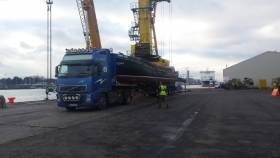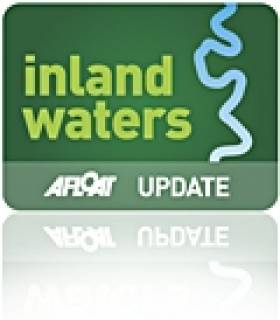Displaying items by tag: Grand Canal Basin
#Visitors - A French naval vessel, a UK based cruiseship and a local excursion boat are in Dublin Port to celebrate St. Patrick’s Day, writes Jehan Ashmore.
The French Navy are represented in the capital with the presence of the small offshore patrol vessel, Cormoran. At just shy of 50m long the craft is on a courtesy call during the festivities having berthed at Sir John Rogersons Quay. The 390 gross tonnage vessel is on a five-day visit.
Cormoran normally patrols EEZ waters off western France, had been the Guardship for the La Solitaire du Figaro Yacht Race that called to Dun Laoghaire Harbour in recent years. Accompanying the French visitor on the Liffey is one of the Irish Navy's smallest units, the coastal patrol vessel, L.E. Orla.
Sister of the Peacock class, L.E. Ciara had also berthed here last week during the call of foreign naval visitor, BNS Castor a Ready Duty Ship of the Belgium Navy. More recently HMS Westminster, a Duke class Type 23 frigate also visited the port but took a downriver berth along Ocean Pier.
Also making a visit to Dublin this St. Patrick’s Day with up to 449 passengers is Saga Pearl II which is on cruise having departed Dover. The call of the small Saga Cruises includes an overnight stay in the capital to give cruise-goers more time to enjoy the attractions and Irish hospitality.
The arrival of Saga Pearl II follows the first cruise visitor of 2017 which came in the form of Fred Olsen's Boudicca. The larger 880 passenger capacity cruiseship made a call within the first week of January, however the cruise season proper gets underway next month in late April.
As thousands of Dubliners and visitors also from overseas throng the capital’s thoroughfare for today's St. Patrick’s Day Parade, there are those taking the sights of the capital from offshore. This is been carried out by Dublin Bay Cruises excursion boat, St. Bridget.
The former Aran Islands ferry had undergone work at Howth Boatyard in advance of seasonal cruises. Up until now the 100 assenger boat had been wintering in Dublin’s Grand Canal Dock Basin from where she departed in recent days.
St. Bridget operates cruises from Sir John Rogersons Quay. Almost facing opposite on the far bank is based replica 19th century museum famine-emigrant tallship Jeanie Johnston. The barque this week finally returned to its home-berth in the city-centre at Custom House Quay having undergone maintenance dry-docking.
Guided tours that tell the tales of Irish emigration during the famine to North America are brought to life on board the tallship.
#EscapeRoom - The ‘escape room’ business initially an Asian craze has arrived in Ireland and appears to be booming at the moment.
The latest addition to the sector was launched in Dublin yesterday afternoon – and its backers are hoping to stand out from their competitors by offering something a little different: Ireland’s first ‘escape boat’.
“We’ve done a lot of research on escape rooms,” Ronan Brady of escapeboats.ie told TheJournal.ie at Dublin Port as he watched the soon-to-be-refitted Zorg Ella barge being lowered into the Liffey.
I’ve travelled around Europe doing a lot of them and we’ve done all the ones in Dublin – and we think there’s room for huge improvement.
Brady, who has teamed up with Irish Ship and Barge Fabrication for the new venture, hopes to have the attraction up and running on Grand Canal Quay, near the Bord Gáis Energy Theatre, by spring.
They’ve spent months sourcing props for the 101-year old ship and thinking of ideas for the different rooms on board, he said.
To read more on this new craze, click here.
Navigation Notice For Dragon Boat Regatta This Weekend
#InlandWaters - Waterways Ireland advises masters and owners that the Dragon Boat Regatta will take place in Dublin's Grand Canal Basin this weekend Saturday 13 and Sunday 14 September.
The event will be running both days from 8am to 6pm. Masters are requested navigate with due caution if transiting the basin on these days and note the advice of safety boat marshals.
Entries Open For IUSRU Raft Race at Docklands Summer Fest
#InlandWaterways - The Irish Underwater Search and Recovery Unit (IUSRU) has announced details of its Raft Race as part of the Waterways Ireland Docklands Summer Festival.
Entry is €25 per person with four persons per raft for the day of wackiness on the water at Grand Canal Basin on 19 May.
And for those who can't build their own raft in time, prebuilt rafts can be supplied by the organisers.
More details of the event can be had from the IUSRU at 087 975 8656 or [email protected].
The complete programme of events for the Docklands Summer Festival will be posted on the official website shortly.
Waterways Ireland wishes to advise masters and owners that as part of the Docklands Summer Festival, yacht racing will take place in the Grand Canal Basin from 09.00 hrs until 16.00hrs on Sun 26th June.
On Sat 25th, there will be a practice session from 13.00hrs until 19.00hrs.
In addition 'Come and Try It' activities including canoeing and paddle-boarding for novices will take place in the inner basin beside the Waterways Ireland Visitors Centre, from 10.00hrs until 18.00 on both days.
There will be restricted movement of vessels in the Grand Canal Basin during the events, lock operations will be suspended once the events have commenced.
Commercial operators in the Dock are requested to adhere to these restrictions and the planned routes and schedules for the duration of the event.
Boat owners presently in the Grand Canal Basin should comply with all reasonable instructions and guidance from event marshals.
































































